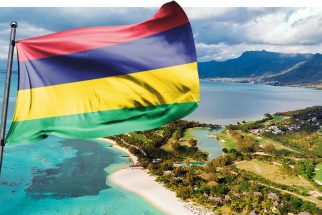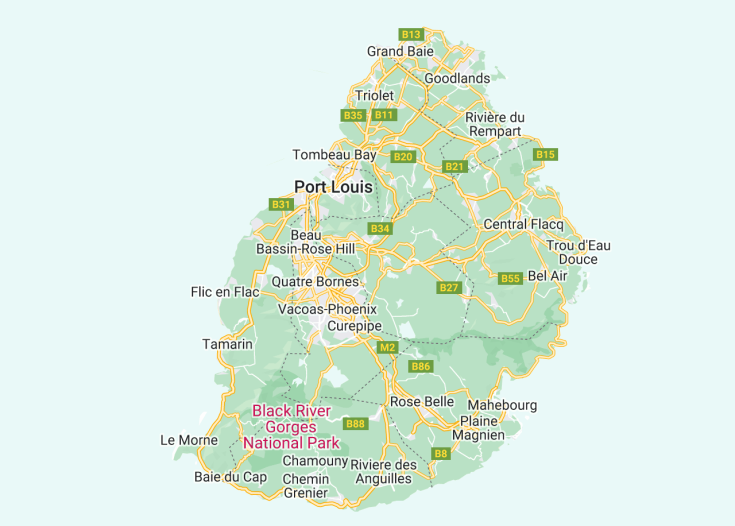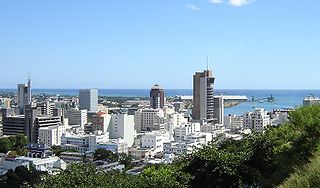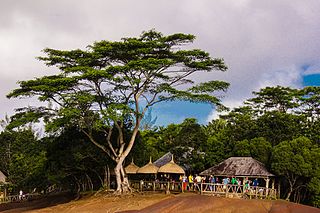Emerging from the azure waters of the Indian Ocean, Mauritius is a gem of unparalleled beauty. This tropical paradise, with its mosaic of cultures, unfolds a tapestry of pristine beaches, lush green forests, and volcanic landscapes. Its rich heritage, derived from African, European, and Asian influences, has sculpted a unique cultural palette, making Mauritius a harmonious symphony of traditions, flavors, and colors, poised against a backdrop of natural splendor.
Explore the local markets of Port Louis for authentic Mauritian souvenirs and a taste of the island’s diverse culinary scene.
Consider visiting during the cooler months of May to October, when the island enjoys a mild and pleasant climate, perfect for beach and nature activities.
Top destinations in Mauritius
Mauritius: an island paradise
| Capital | Port Louis |
| Time in Mauritius | GMT +4 |
| Language spoken | English |
| Population | 1.27 million people (World Bank, 2020) |
| Religion | Hinduism (48.5%), Christianity (32.7%), Islam (17.3%) |
| Currency | Mauritian Rupee (MUR) |
| Airports | Sir Seewoosagur Ramgoolam International Airport |
Mauritius, a tropical paradise in the Indian Ocean, is a dream destination for travelers seeking natural beauty, vibrant cultures, and warm hospitality. This small island nation is renowned for its stunning beaches, turquoise waters, and diverse marine life. Mauritius holds a rich history, influenced by various colonial powers such as the Dutch, French, and British.
Located in the southwestern part of the Indian Ocean, Mauritius is a relatively small island with an area of approximately 2,040 square kilometers. It is situated about 900 kilometers east of Madagascar. The capital of Mauritius is Port Louis, a bustling city that blends modern infrastructure with historic landmarks.
Where is Mauritius located?
Mauritius is located in the southwestern part of the Indian Ocean, east of Madagascar. It is an island nation known for its pristine beaches, lush greenery, and vibrant culture.
What is Mauritius famous for?
Mauritius is famous for its breathtaking beaches, coral reefs, and abundant marine life. The country is also renowned for its luxury resorts, offering visitors a chance to indulge in relaxation and tropical paradise. Additionally, Mauritius is celebrated for its diverse cuisine, influenced by its Indian, Chinese, and European heritage.
History
Prehistoric Era: The Uninhabited Island
Before the age of exploration, Mauritius was untouched by human inhabitants. The island’s isolation in the Indian Ocean left it uninhabited, though it was known to medieval Arab and Malay sailors. Instead, its shores and dense forests were home to a plethora of unique wildlife, most famously the dodo bird, which became extinct in the 17th century due to human interference.
1507 – 1598: Early European Discoveries
The Portuguese were the first Europeans to explore Mauritius, with navigator Diogo Fernandes Pereira landing on the island in 1507. Although the Portuguese marked the island on their maps, they did not establish a permanent settlement. For nearly a century, Mauritius remained largely undisturbed by European powers, serving as a brief stopover for ships en route to the East Indies.
1638 – 1710: Dutch Colonization
In 1638, the Dutch established the first permanent settlement on Mauritius, naming the island after Prince Maurice van Nassau. However, their tenure on the island was marked by challenges, from cyclones to difficulties in establishing sustainable agriculture. Despite introducing crops like sugarcane and domestic animals to the island, the Dutch abandoned Mauritius in 1710 after several attempts at colonization.
1715 – 1810: French Rule and Development
Five years after the Dutch departure, the French claimed Mauritius, renaming it “Isle de France.” Under French rule, the island underwent significant development. Port Louis was established as a strategic naval base and a vibrant port. The French brought enslaved people from Africa and Madagascar to work the sugarcane plantations, which became the backbone of the Mauritian economy. This period also witnessed the introduction of the French language and legal system, which have left a lasting impact on the island nation.
1810 – 1968: British Rule and the Path to Independence
Amidst the Napoleonic Wars, the British sought to control the strategic island and, after the Battle of Vieux Grand Port, the only naval battle won by the French during these wars, the British took over in 1810. Under the Treaty of Paris in 1814, Mauritius was formally ceded to Britain. The British continued the cultivation of sugarcane, but with the abolition of slavery in 1835, they brought indentured laborers from India. This mass migration has significantly shaped the culture, cuisine, and demographics of Mauritius. The 20th century saw a rise in the Mauritian nationalist movement, and after years of political evolution and negotiation, Mauritius achieved independence in 1968.
1968 – Present: Independent Mauritius
Upon gaining independence, Mauritius adopted a democratic system and has since remained politically stable. The nation has progressed economically, transitioning from a primarily agriculture-based economy to a diversified one, with significant contributions from tourism, finance, and information technology. Its rich cultural mosaic, formed from centuries of European, African, and Asian influences, has made Mauritius a vibrant, multi-ethnic, and multi-religious nation. Today, Mauritius is hailed as a testament to peaceful coexistence and successful development, holding a prominent position among African and Indian Ocean nations.
Visit Mauritius
What to see and do in Mauritius
When visiting Mauritius, there are several attractions and activities that should not be missed:
- Explore the beautiful beaches: Mauritius is renowned for its pristine white sand beaches and turquoise waters. From popular spots like Trou aux Biches and Blue Bay to hidden gems like Grande Rivière Noire and Le Morne, there is a beach for every preference.
- Visit Port Louis: The capital city of Mauritius is a vibrant mix of cultures and offers a variety of attractions. Explore the colorful Central Market, discover the history of the island at the Blue Penny Museum, and indulge in delicious street food at the Caudan Waterfront.
- Discover the natural wonders: Mauritius is home to spectacular natural landscapes. Visit the Seven Colored Earths in Chamarel, an area of sand dunes with different vibrant colors. Hike through the Black River Gorges National Park and enjoy breathtaking views of waterfalls and lush vegetation.
- Experience water sports: With its crystal-clear waters, Mauritius is a paradise for water sports enthusiasts. Try snorkeling or diving to explore the vibrant marine life, go sailing or windsurfing, or embark on a dolphin-watching excursion.
- Learn about the history and culture: Visit historical sites like the Aapravasi Ghat, a UNESCO World Heritage Site that symbolizes the indentured laborers’ arrival, and the Eureka House, a beautifully preserved colonial mansion. Attend a cultural show or visit one of the many temples, mosques, and churches that reflect the island’s diverse heritage.
Events in Mauritius
Mauritius hosts a variety of events throughout the year, showcasing its vibrant culture and traditions:
– Séga Festival (January): This music and dance festival celebrates the traditional Séga, which is considered the national dance of Mauritius. Visitors can enjoy live performances, workshops, and immerse themselves in the lively atmosphere.
– Cavadee Festival (February/March): A religious festival celebrated by the Tamil community, the Cavadee Festival involves devotees carrying a wooden arch adorned with flowers and piercing their bodies with skewers as a form of penance.
– Chinese Spring Festival (February): The Chinese community in Mauritius celebrates the Lunar New Year with colorful parades, dragon and lion dances, and traditional performances.
– Divali (October/November): Also known as the Festival of Lights, Divali is a major Hindu festival celebrated with the lighting of clay lamps, fireworks, and the exchange of sweets. It is a time of joy, unity, and spiritual reflection.
– Rodrigues International Kite Festival (June/July): The neighboring island of Rodrigues hosts an annual kite festival, where participants showcase their artistic and innovative kite designs against the backdrop of scenic beaches.
Best time to visit Mauritius
The best time to visit Mauritius is during its dry season, which runs from May to December. The weather is generally pleasant with cooler temperatures and lower humidity. This period is ideal for outdoor activities, such as exploring the beaches, hiking, and water sports.
It is important to note that Mauritius experiences a tropical climate, with the potential for cyclones during the summer months from December to March. Travelers should check weather forecasts and plan accordingly to avoid any disruptions.
Is Mauritius worth visiting?
Mauritius is definitely worth visiting for those seeking a tropical paradise with a mix of cultural and natural attractions. The island offers stunning beaches, clear turquoise waters, and a wide range of activities for all types of travelers.
The rich history and diverse cultural heritage of Mauritius provide visitors with a unique and immersive experience. Exploring the capital city of Port Louis, discovering the island’s colonial past, and indulging in the local cuisine are just some of the highlights.
Furthermore, Mauritius is committed to sustainable tourism practices and has implemented measures to preserve its natural resources. Travelers can enjoy the beauty of the island while supporting environmentally friendly initiatives.
However, it is important to note that Mauritius is a popular tourist destination, especially during peak seasons. This means that some areas can become crowded, and prices may be higher. To fully appreciate the island’s beauty and avoid the crowds, it is recommended to explore off-the-beaten-path locations and consider visiting during the shoulder seasons.
Overall, Mauritius offers a unique blend of natural beauty, cultural richness, and warm hospitality, making it a worthwhile destination for a memorable vacation.














